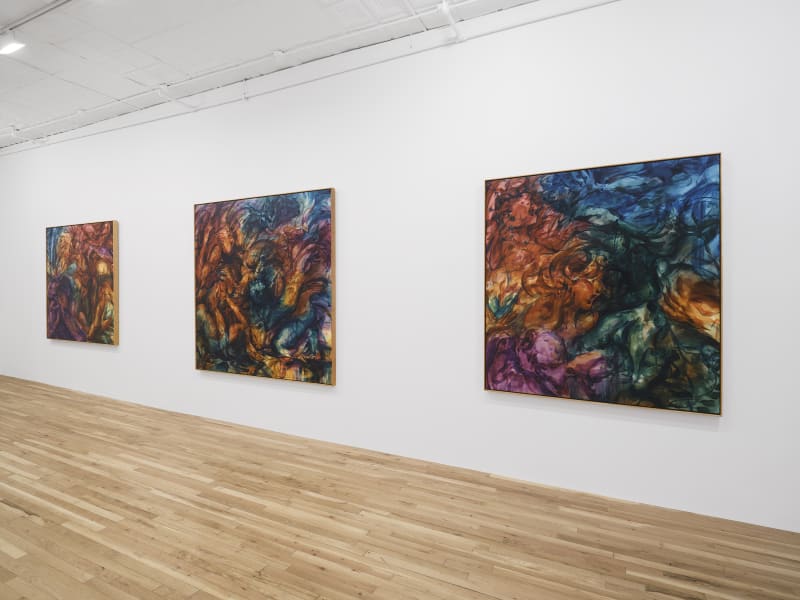In her first US solo show, Riptide at Charles Moffett, Julia Jo embarks on a journey of self-discovery, examining interpersonal relationships in figural paintings that are obscured with swirls of body parts, hints of objects, and glimpses of interiors. Jo's works are all intimate, rooted in the artist's own experiences of moving from Seoul, her birthplace, to the US, where she has continuously relocated, a journey that left her with truncated relationships, miscommunications, and in a constant state of reintroduction and reinvention. Though based on her own life, Jo's paintings convey emotions rather than clear scenarios and embrace an element of ambiguity that allows the viewer to connect on an equally personal level.
Two main palettes make up the works in the show. The majority contain a rainbow of colors: rich red, orange, green, blue, and purple. The second palette is relatively more reserved, limited to a range of orange, green, and blue. Jo builds her compositions with layers of thin oil paint topped with thicker brushstrokes that delineate her subjects. Delicate marks flow across the surfaces, enlivening the paintings further. It's easy to overlook the suggestions of identifiable imagery in Jo's work and instead focus on the colors and the constant movement of shapes, but even a quick glimpse makes it clear how visually stunning the paintings are. There is undeniable beauty in Jo's choice of color and her application of paint.
These details pull the viewer in and invite close inspection. However, Jo's work requires slow viewing both from up close and from afar. Hidden imagery reveals itself over time, sparking memories that the viewer can choose to follow or ignore. The rich colors of Happily Ever After (2022), for example, come together to form various figures and scenes depending on how the viewer looks. A leg bent at the knee and ankle emerges in the blue portion of the work. A red arm and elbow rest on the knee, supporting a face hidden by a hand with manicured nails. Closer looks reveal the figure's second arm and hand, this one bearing a large wedding ring. As she crouches with her head in her hands in apparent distress, an outline of a martini glass emerges. A hand from an unseen figure touches the base of the glass, pushing it enticingly towards the woman. What at first seemed to be a whirlpool of colors and gestural marks reveals its story the longer the viewer looks.
There is undeniable sadness in Happily Ever After, but the backstory is a mystery. Perhaps this is a failed marriage unfolding before our eyes. Like a word association game or a Rorschach test, the connections one makes with the work reveal more about the viewer than about the artist. Jo leaves us free to follow the threads of each piece, unraveling the narratives of our own minds.
Happily Ever After contains one of the few identifiable images in the show with the martini glass. In other works, the only suggestions of something recognizable come in the form of hands, limbs, and faces. With the latter, Jo imbues emotion and intense energy as mouths appear frozen in gasps, screams, and sighs of frustration. She also includes hints of architecture at times to give context to the work. In Back to Square One (2022), for example, a checkered floor is clearly visible in the background, a pattern many viewers who grew up in the eighties and nineties in the US may recognize and have their own associations with. Focusing on this pattern in the bottom right corner of the composition, the eye slowly works through a scene charged with frustration. A figure lies on the checkered floor, peacefully resting their head on their arm. This peace is interrupted as hands appear above the slumbering person's head and seem to open the figure's brain, pulling at memories that spiral into screaming faces of nightmares. Additional hands invade from different angles, digging deeper into the person's mind. There is a sense of desperation in the figure's resting place on the floor that is made further miserable by the relentless endeavor to interrupt sleep.
Every work in Riptide seems to suck the viewer in, screaming the emotional tales latent within each composition. After wading through these rainbow-hued scenes in the front room, the viewer emerges in the back of the gallery where the palette changes completely and the orange, green, and blue hues take over. In this room, the emotional struggle apparent in the first group gives way to a physical struggle. Bodies seem to be in frantic motion, moving against some force, perhaps a riptide as the exhibition title suggests.
Jo's ability to communicate emotions and experiences with minimal context is precisely what makes her work so powerful and deeply relatable. Viewers can read their own stories in the scenes, following the breadcrumbs Jo has left behind. In many ways this subjectivity and openness of interpretation parallels the tenuous state of our interpersonal connections that the artist set out to portray. Miscommunications are inevitable in our relationships, a fact Jo knows well having moved so frequently in her life. Rather than lament this reality, however, Jo embraces it as one of the things that makes us uniquely human. Ambiguity in life abounds. The best we can do is wade through the riptide.
Julia Jo: Riptide
Annabel Keenan, The Brooklyn Rail, 1 February 2023
gallery@charlesmoffett.com
Location
394 Broadway, Second Floor, New York, NY 10013.
Phone
212.226.2646
© Copyright 2025 Charles Moffett
This website uses cookies
This site uses cookies to help make it more useful to you. Please contact us to find out more about our Cookie Policy.


